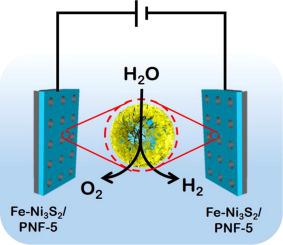Journal of Colloid and Interface Science ( IF 9.4 ) Pub Date : 2022-09-07 , DOI: 10.1016/j.jcis.2022.09.007 Bo Zhong 1 , Bei Cheng 1 , Yanbing Zhu 2 , Rui Ding 2 , Panyong Kuang 3 , Jiaguo Yu 4

|
Alkaline water electrolysis (AWE) offers a promising route for green hydrogen production. However, its industrial application is impeded by unsatisfactory energy conversion efficiency. Herein, a robust electrode composed of porous nickel foam (PNF) and Fe-doped Ni3S2 (Fe-Ni3S2) nanosheet arrays was fabricated and applied for industrial AWE. By conducting a scalable dynamic bubble-template method, PNF with high loading of active catalysts was prepared. The superhydrophilicity of PNF facilitates bubble detachment and promotes mass transfer, especially at high current densities. In addition, Fe-Ni3S2 with optimized electronic structure is featured with enhanced electrical conductivity, sufficient exposure of active sites, and optimized adsorption of intermediates. Benefiting from the concerted advantages of PNF and Fe-Ni3S2, the obtained Fe-Ni3S2/PNF-5 electrode with an optimal Fe content of 5 mol% exhibits high catalytic activity for both hydrogen evolution reaction (HER) and oxygen evolution reaction (OER). Compared with the Pt/C/NF||IrO2/NF couple, the Fe-Ni3S2/PNF-5||Fe-Ni3S2/PNF-5 couple delivers a current density of 10 mA cm−2 at a low cell voltage of 1.50 V for AWE. Under industrial conditions, a competitive cell voltage of 1.75 V is needed for achieving a high current density of 400 mA cm−2. Besides, the couple can operate stably for 120 h, outperforming the commercial RN||RN couple. This work provides a novel strategy to elevate the loading amount of catalysts and improve the electrochemical performance of the electrode for practical AWE application.
中文翻译:

用于高电流密度碱性水分解的分层多孔镍泡沫支撑的 Fe-Ni3S2 电极
碱性水电解(AWE)为绿色制氢提供了一条有前景的途径。然而,其工业应用受到不令人满意的能量转换效率的阻碍。在此,制造了由多孔镍泡沫(PNF)和掺杂铁的Ni 3 S 2(Fe-Ni 3 S 2)纳米片阵列组成的坚固电极,并将其应用于工业AWE。通过进行可扩展的动态气泡模板法,制备了高负载活性催化剂的 PNF。PNF 的超亲水性有助于气泡分离并促进传质,尤其是在高电流密度下。此外,Fe-Ni 3 S 2具有优化的电子结构,具有导电性增强、活性位点暴露充分、中间体吸附优化等特点。受益于 PNF 和 Fe-Ni 3 S 2的协同优势,得到的 Fe-Ni 3 S 2 /PNF-5 电极的最佳 Fe 含量为 5 mol%,对析氢反应 (HER) 和析氧反应(OER)。与Pt/C/NF||IrO 2 /NF 对相比,Fe-Ni 3 S 2 /PNF-5||Fe-Ni 3 S 2 /PNF-5 对提供10 mA cm -2的电流密度对于 AWE,电池电压为 1.50 V。在工业条件下,需要 1.75 V 的具有竞争力的电池电压才能实现 400 mA cm -2的高电流密度。此外,这对夫妇可以稳定运行 120 小时,优于商业 RN||RN 夫妇。这项工作为提高催化剂的负载量和改善电极的电化学性能提供了一种新的策略,用于实际的 AWE 应用。











































 京公网安备 11010802027423号
京公网安备 11010802027423号